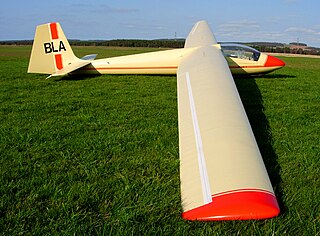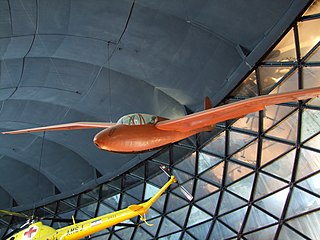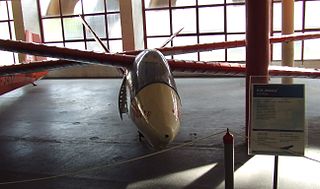The Schneider ES-59 Arrow is a sailplane designed and manufactured in Adelaide, South Australia in the early 1960s. The Arrow was manufactured with a one-piece wing of 13.23 metres span. It was the first Australian-built sailplane to compete in the World Gliding Championships, 1963 in Argentina. The Arrow has wood/fabric wings and tail and a wood fuselage.

The Slingsby T.41 Skylark 2 was a sailplane produced from 1953 at Kirbymoorside, Yorkshire by Slingsby Sailplanes
The Slingsby T.37 Skylark 1 was a sport sailplane of moderate dimensions, built during 1952-3 at Kirbymoorside, Yorkshire by Slingsby Sailplanes

The Standard Austria was a single-seat aerobatic glider that was originally designed and built in Austria from 1959 but production was moved in 1962 to Schempp-Hirth in Germany.

The SZD-24 Foka (Seal) was a single-seat high performance aerobatic glider designed and built in Poland in 1960.

The IS-4 Jastrząb was a single-seat aerobatic glider designed and built in Poland from 1949.
The IS-5 Kaczka was a single-seat canard research glider designed and built in Poland from 1948.

The Slingsby Type 34 Sky is a high performance single seat competition sailplane built in the United Kingdom. It was successful in major events, particularly in the World Gliding Championships of 1952.

The Slingsby Type 45 Swallow was designed as a club sailplane of reasonable performance and price. One of the most successful of Slingsby's gliders in sales terms, over 100 had been built when production was ended by a 1968 factory fire.

The Slingsby T.50 Skylark 4 was a British single seat competition glider built by Slingsby Sailplanes in the early 1960s. It sold in numbers and had success at national, though not world level competition.
The Neiva BN-1 was a high performance single seat sailplane designed in Brazil in the 1950s. It had national record and competition success and went into production for club use.

The Wassmer WA-30 Bijave is a French two-seat advanced training glider designed and built by Wassmer Aviation of Issoire.
The Czerwiński-Shenstone Harbinger, aka the Shenstone-Czerwiński Harbinger or the Shenstone Harbinger was a Canadian high performance tandem seat sailplane designed in Canada. Only two were built, one in the UK and one in Canada. The latter did not fly until 1975, being under construction for 26 years; the former remained active until at least 1994.

The HKS-1 was a German 19 19 m (62.3 ft) span high performance two seat sailplane, designed around 1950 to use recent advances in laminar flow airfoils. To avoid premature transition from laminar flow caused by surface interruptions, the HKS-1 dispensed with hinged ailerons, flaps and spoilers and replaced them with a flexible trailing edge. Two were built, setting several records.

The Ikarus Košava is a two-seat sailplane designed and built in Yugoslavia in the early 1950s. It won the 1954 World Gliding Championships in the two seat category and came second in the same event two years later.

The Breguet Br 104 Nymphale is a two-seat training and competition sailplane, built in France in the 1950s. A direct development of the successful Breguet Br 901 Mouette, it competed at two World Gliding Championships but has mostly been used, in small numbers, by gliding clubs.

The Ikarus Meteor is a long-span, all-metal sailplane designed and built in Yugoslavia in the 1950s. It competed in World Gliding Championships (WGC) between 1956 and 1968 and was placed fourth in 1956; it also set new triangular-course world speed records.

The Rubik R-25 Mokány, in English: Plucky person and sometimes known as the R-25 Standard (class), is a Hungarian single seat Standard Class glider of all-metal construction, first flown in 1960. It was one of a series of similar aircraft designed by Ernő Rubik. Only one was built.
The Bréguet Br 902 Cinzano was a French training glider produced in the 1950s by Société anonyme des Ateliers d'aviation Louis Bréguet



















